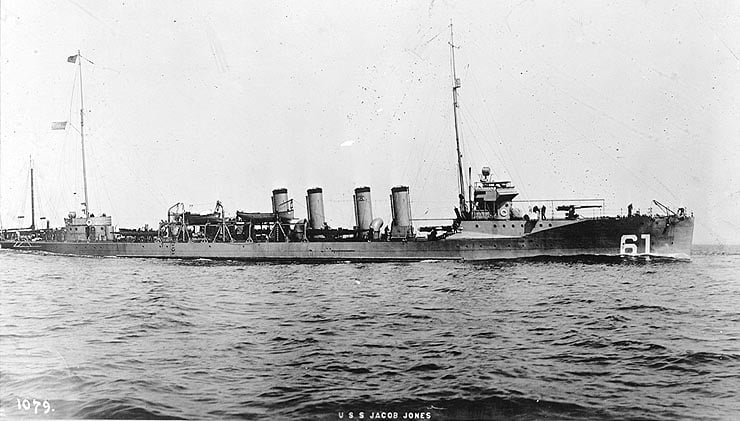Simon T. Murphy & The Sinking Of The USS Jacob Jones
Originally published on Rockford Buzz.
Note: We’ve just published an update to this story. Click here to read it: Update: The wreck of the USS Jacob Jones has been found.
Simon T. Murphy was just an average guy living in Rockford. He had a good childhood living on the family farm with his four brother and two sisters. His mother, Mary died young and his father, Thomas moved the family to Rockford so they could attend school.
In 1917, Simon was twenty-six years old and working at the Standard Oil Company on Kilburn Avenue. He was popular with his co-workers. They had heated discussions about whether the United States should get involved in the “Great War” as they called it. They all knew what Simon thought about the whole thing, of course. He was very outspoken about joining the battle. No one was surprised when Simon was one of the first men to enlist after war was declared in April 1917.
They weren’t surprised when Simon was assigned to one of the large destroyers, either. Simon, like a lot of people in Rockford had heard about the danger from the German U boats. The stories of the civilians killed on the Lusitania had been told and retold many times since the sinking of the great ship.
Simon was thrilled to be assigned to the USS Jacob Jones (Destroyer No. 61) as a Fireman Third Class. It was a “submarine hunter”, built especially to chase them down and shoot them out of the water. It must have felt strange to Simon when the Jacob Jones was attached to the port of Queensland, Ireland. Though Simon’s father was born in Wisconsin, his grandfather and grandmother were both from Ireland.
The USS Jacob Jones was one of America’s newest and largest of the Destroyers. She was placed in the care of Commander David Bagley. He spent months patrolling the water, looking for the German submarines and training his men. They would soon earn a reputation as relentless submarine chasers. They also were able to save many lives of sailors whose boats were sunk by the deadly German torpedoes. On July 8, they rescued 44 men from the Valetta, a British steamship; 25 men were saved from the steamship Dafila around July 25 and on October 19, they pulled 305 men from water after the sinking of the auxiliary cruiser Orama.
In early December, the Jacob Jones was on its return trip after escorting a troop convoy to France. The weather was awful with stormy skies that caused choppy seas. It was approaching midnight when a watchman spotted a torpedo heading straight for the Jones. Lt. Stanton Kalk was the officer of the deck at the time and though he tried to alter the ship’s course, it was no use. The torpedo hit the starboard side aft and penetrated a fuel oil tank, causing a devastating explosion. Many of the men below deck were killed immediately by the explosion or drowned as the water rushed into the ship. The ship sank in just eight minutes.
Even more died when the ship’s depth charges spilled from below decks and fell toward the bottom. They had been triggered to go off at certain measurements and new explosions took even more lives as each charge reached their assigned depth.
The sinking happened so fast that no distress calls were sent out and there was no time to release the rescue boats. Several men were able to grab the rafts that set around the deck. Lt. Kalk was able to pull several men onto the rafts and stabilize them as other men grabbed hold. Kalk swam from raft to raft and pulled men aboard and kept the weight even to keep them from capsizing. He would do this until he was too exhausted to cling to a raft himself and his body slipped under the waves.
The German submarine that shot the deadly torpedo was the U-53. In what could only be described as a strange twist of fate, the Commander of the submarine was Kapitan Hans Rose. He had actually visited the United States in 1917 on his submarine and had met Commander Bagley. Kapitan Rose recognized Bagley in his binoculars right before the torpedo hit the ship. Though no one would know until months later, Kapitan Rose radioed Queensland to report the Jacob Jones sunk and give her last location to quicken the rescue ships arrival. He also picked up two men who had been severely wounded. These men heard the radio call and told of it later when they were released after the armistice in November 1918.
Over 110 men served on the USS Jacob Jones before December 6, 1917. Rescue ships were able to save forty six men the next morning when they finally arrived. One does not want to even imagine what those men went through on that horribly cold, dark night. Those that survived were reluctant to talk about it. And those that interviewed them for information were horrified to have to make them relive it.
But as horrific as the stories were, they were also filled with pride. Many of the stories were filled with courageous, selfless acts. One such story told of the men who shared what little dry clothing they had with those who were washed over-board with little clothing to protect them. Others worked to lift the men’s spirit by telling jokes or singing songs. In truth, it was a miracle that any of them were alive when the British ships arrived the next morning.
The forty six men were hauled on board the British ships fed and given medical attention. Some had terrible burns and all of them suffered from hypothermia. The survivors were sent home for a time to heal. The majority of them returned to the sea and continued the fight when the war intensified in the spring of 1918.
Simon was killed over a hundred years ago and he was only one of dozens of men and women from Rockford who have served our country. Memorial Day was set aside as a day of remembrance to those who paid the ultimate sacrifices and their families who lost so much. My hope is that by sharing Simon’s story that you will take a moment to remember him and the others as you gather with your friends and families on Monday, May 27.
Copyright © 2019 Kathi Kresol, Haunted Rockford Events



